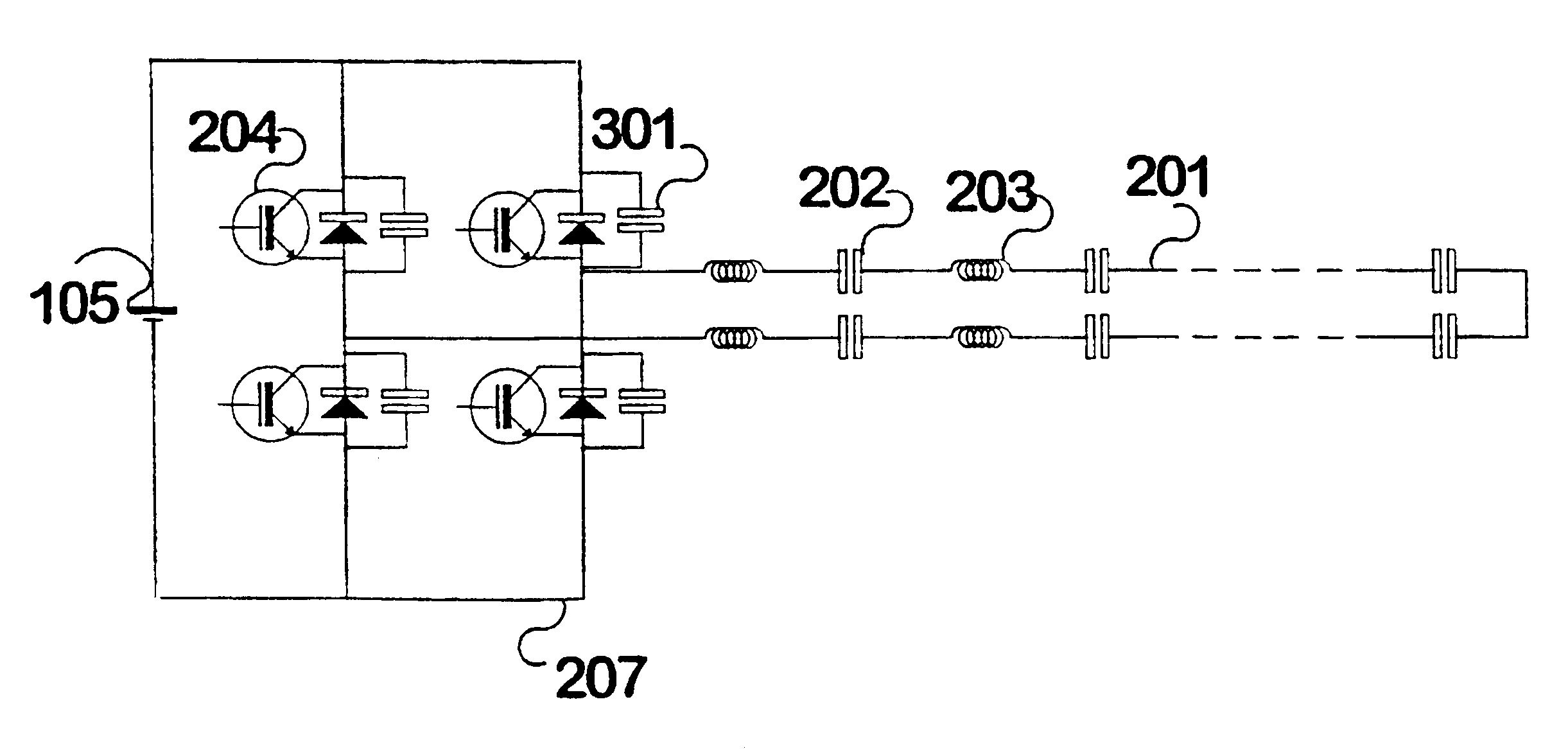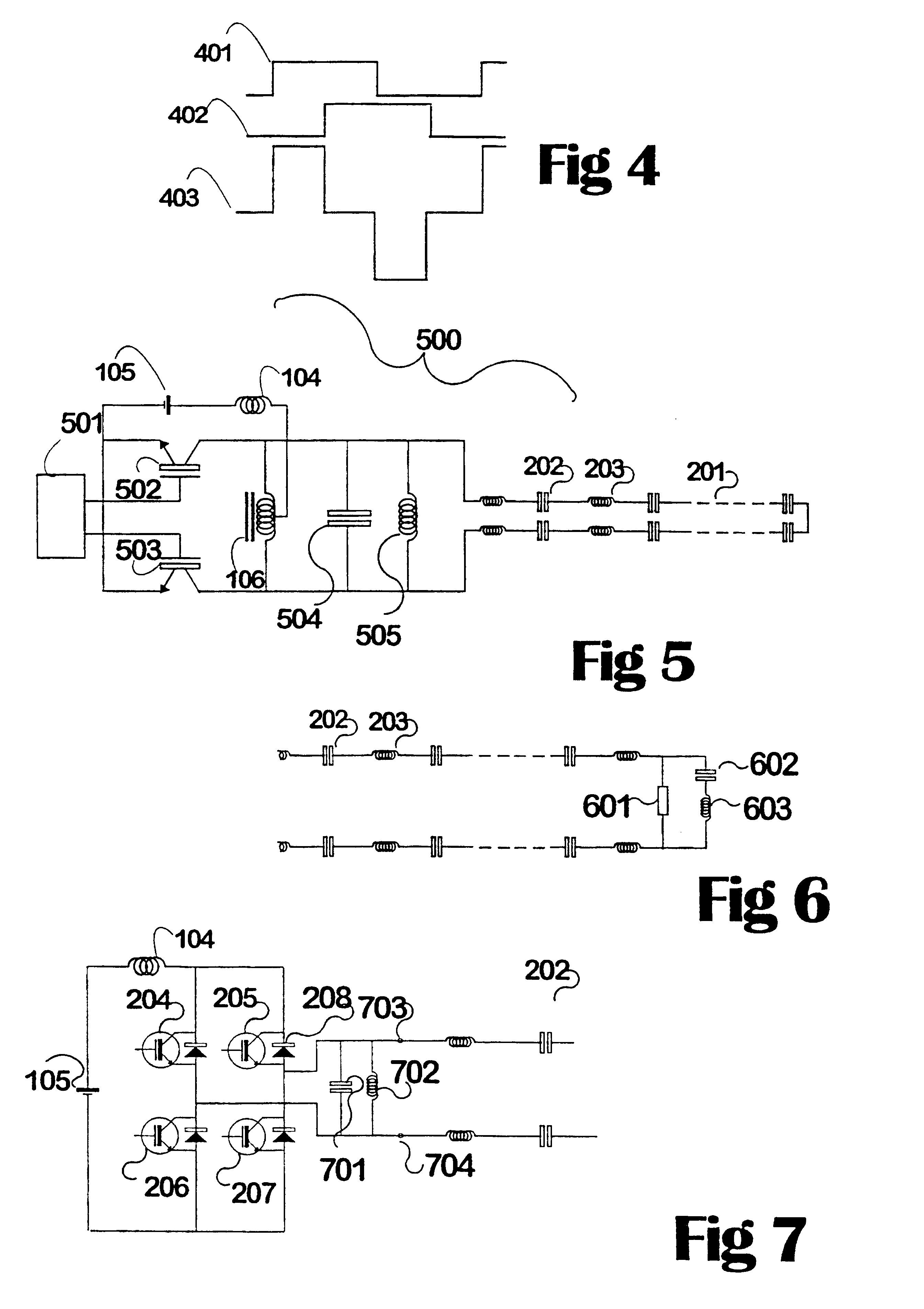Supply of power to primary conductors
a technology of primary conductors and supply voltage, which is applied in the direction of inductance with magnetic cores, transmission, cores/yokes, etc., can solve the problems of high voltage required difficult to drive parallel-tuned tracks long, and limit the voltag
- Summary
- Abstract
- Description
- Claims
- Application Information
AI Technical Summary
Benefits of technology
Problems solved by technology
Method used
Image
Examples
example 1 (fig.2)
EXAMPLE 1 (FIG. 2)
This example comprises a full-bridge switching circuit in which each arm of the bridge is occupied by a switch and no resonating components exist within the circuit. A circuit illustrating the principle is illustrated in FIG. 2. Our preferred switches are insulated-gate base transistors (IGBTs) and our preferred operating frequency is generally at about 10 kHz, although IGBT devices are becoming increasingly capable of high-speed operation. The series resonant track is indicated at 201 and comprises a series of series capacitors 202, in series with track inductance 203 (here the track inductance is shown as a lumped symbol).
In the simple form at least, each of the four switches (204, 205, 206, 207) is operated in a 180 degree conduction angle, and current passes alternately from a DC supply 105 through 204, then through the track, then 207, or from the DC supply though 205, through the track in the opposite direction, and then 206, to reach the DC return path. Diod...
example 2 (fig.3)
EXAMPLE 2 (FIG. 3)
Zero-Voltage Switching (Soft switching)
The prior-art half-bridge resonant converter of FIG. 1 could easily be controlled so as to switch at each zero-voltage instant--a feature which minimises switching losses and the generation of interference. The circuit of FIG. 2 assumed that zero-voltage switching was not intended. We have found that if the circuit of FIG. 2 is driven at a frequency slightly above the resonant frequency of the track and if we also include a small capacitor 301 across each switching device, as shown in FIG. 3, it is then possible to take advantage of the inductive impedance of the track in order to attain zero-voltage switching. A residual track inductance discharges the parallel capacitors during switching transitions. The small capacitors are each of the order of 100 to 1000 nF (example capacitor used at 15 kHz--where switches are 300 A, 1200 V IGBTs are WIMA 0.22 .mu.F FKP1). Of course the "lock-out" time between switching the top and bottom...
example 3 (fig.5)
EXAMPLE 3 (FIG. 5)
While the full-bridge converters described above have some control advantages, they also suffer from the significant drawback that the full circulating current passes through the switching devices. If a half-bridge power supply could be modified so that it can provide current to a series-compensated track, one would expect that the switching devices would be much more lightly loaded. Furthermore the drive current provided by the previous example is relatively rich in harmonics. Even though the higher harmonics see a higher impedance, at least part of those higher harmonics are radiated.
In FIG. 5, the circuit 500 drives a series resonant primary inductive loop 20; including lumped capacitors 202 and distributed (track) inductances 203 from a half-bridge pair of switches 502, 503 using an internal resonant circuit comprising an inductor 505 and capacitor 504 as a resonant circuit across which the loop is connected. The values of the components may be entirely determi...
PUM
 Login to View More
Login to View More Abstract
Description
Claims
Application Information
 Login to View More
Login to View More - R&D
- Intellectual Property
- Life Sciences
- Materials
- Tech Scout
- Unparalleled Data Quality
- Higher Quality Content
- 60% Fewer Hallucinations
Browse by: Latest US Patents, China's latest patents, Technical Efficacy Thesaurus, Application Domain, Technology Topic, Popular Technical Reports.
© 2025 PatSnap. All rights reserved.Legal|Privacy policy|Modern Slavery Act Transparency Statement|Sitemap|About US| Contact US: help@patsnap.com



